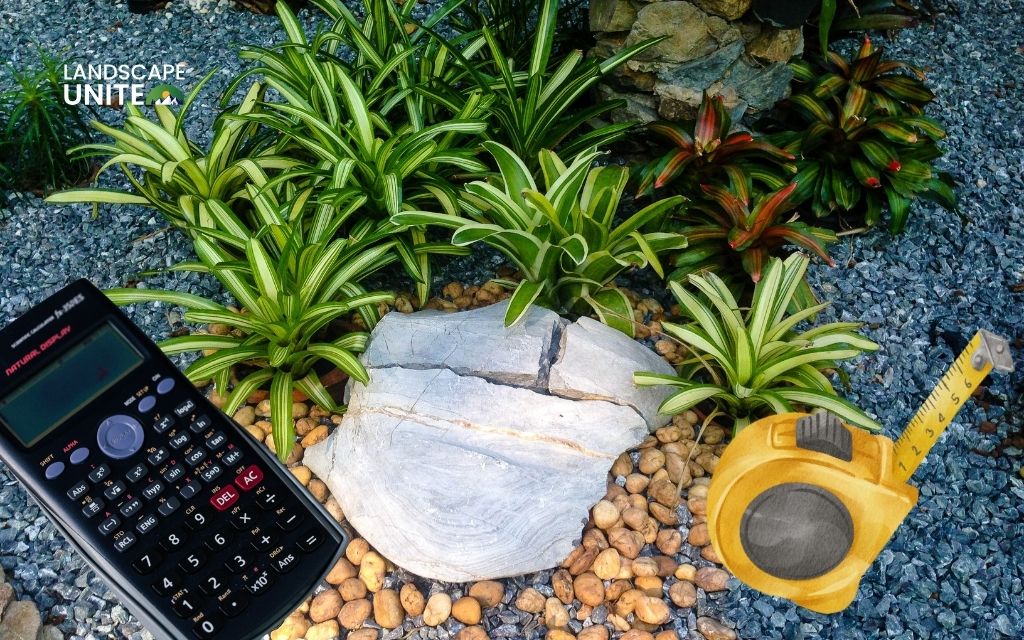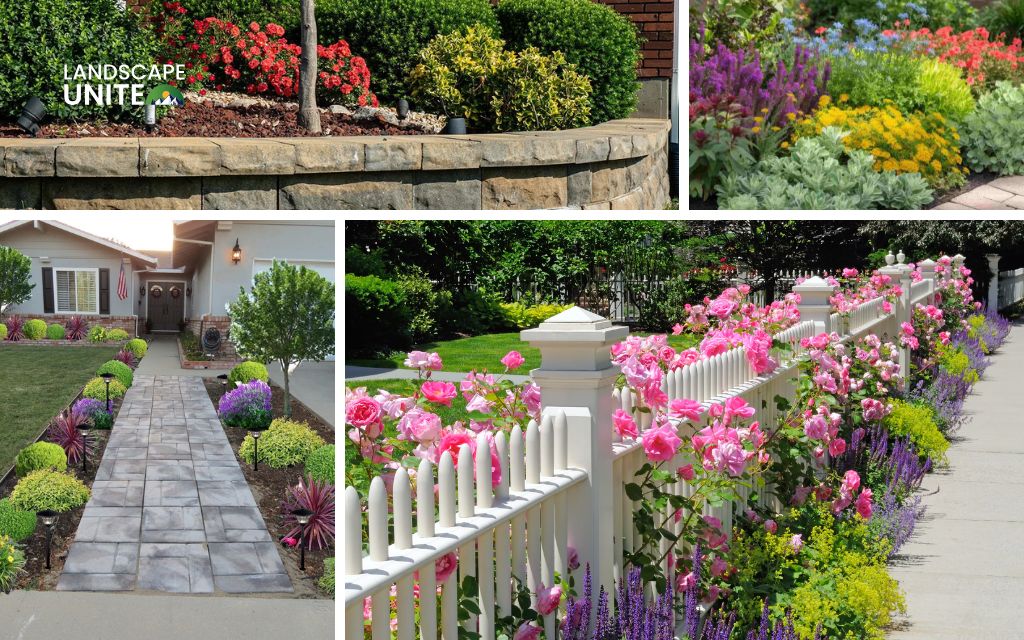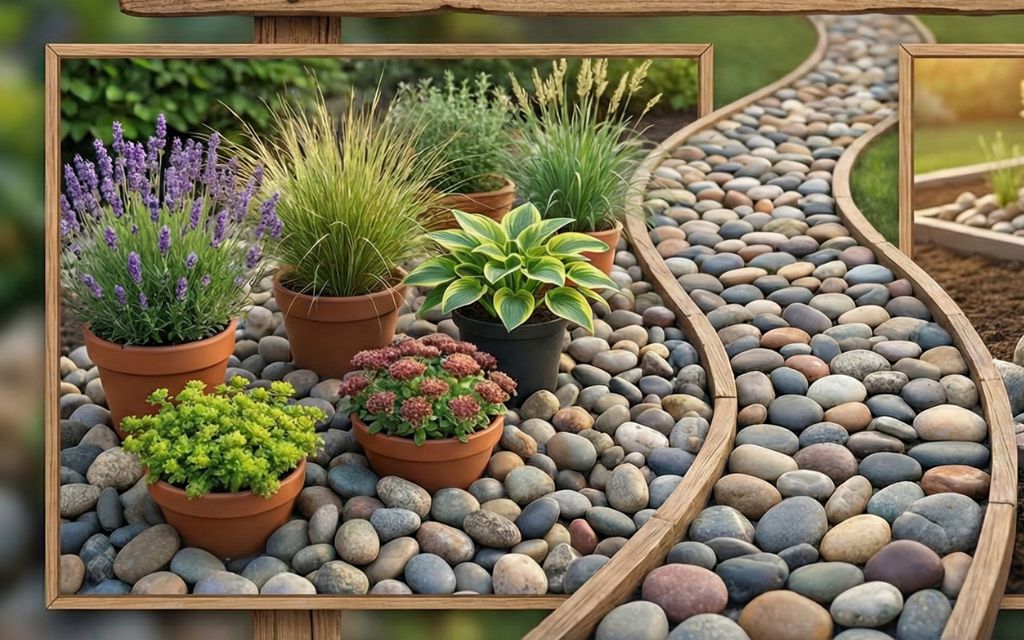Imagine stepping into your yard and being greeted by waves of vibrant blooms, buzzing bees, and dancing butterflies. All this happens with minimal maintenance on your part. Wildflower gardens offer exactly this: natural beauty that practically cares for itself while supporting local ecosystems. Unlike traditional landscapes requiring constant mowing, watering, and chemical treatments, wildflower gardens thrive on benign neglect once established.
Whether you have a sprawling backyard or a modest front yard strip, wildflower garden ideas can transform any space into a pollinator paradise. From cottage-style borders to sweeping meadows, these gardens adapt to your vision while reducing your environmental footprint. In this comprehensive guide, we’ll explore 33+ inspiring wildflower garden ideas, practical planting strategies, and expert tips to help you create a stunning, sustainable landscape that evolves beautifully through the seasons. Ready to let your garden grow wild?
Now let’s explore diverse wildflower garden ideas that work for different spaces, styles, and purposes. Whether you’re working with a small urban plot or acres of open land, you’ll find inspiration here.
33 stunning wildflower garden ideas for small spaces
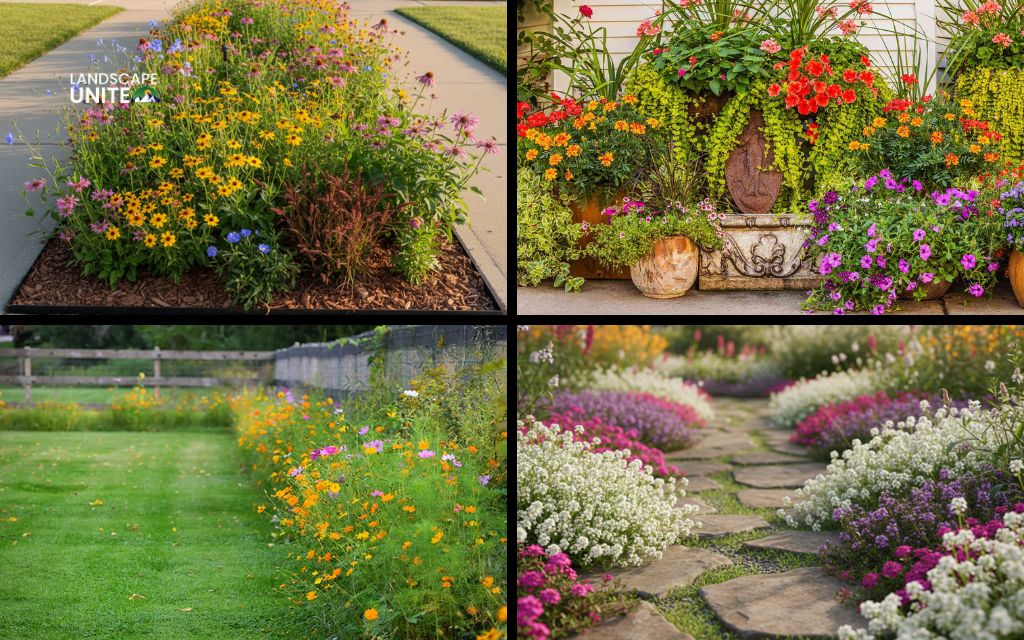
1. Mini meadow front yard strip
Transform that narrow strip between your sidewalk and street into a pollinator pathway that’s both beautiful and functional. These parking strips often feature terrible soil and receive little care, making them perfect candidates for wildflower conversion. Choose a regionally appropriate wildflower seed mix and create defined edges with metal or plastic landscape edging to satisfy neighbors who prefer neat appearances.
2. Container wildflower garden
Don’t let apartment living or limited outdoor space stop you from enjoying wildflowers. Cosmos, Coreopsis, and dwarf varieties of Rudbeckia thrive in containers on patios and balconies. Use large pots at least 12 inches deep, fill them with standard potting mix rather than garden soil, and enjoy portable wildflower beauty. This approach works especially well for renters who want wildflower gardens without permanent landscape changes.
3. Wildflower garden borders
Frame your vegetable garden, perennial beds, or foundation plantings with wildflower borders that soften edges and attract beneficial insects. Keep border plantings under 24 inches tall to avoid overwhelming other garden features. Choose a limited color palette that complements your existing landscape for cohesive design. These borders require minimal space but deliver maximum visual impact and pollinator support.
4. Pathway edging with wildflowers
Low-growing wildflowers like Sweet Alyssum, Creeping Thyme, and Moss Verbena create charming pathway edges that soften hardscaping. Plant these along gravel paths, stepping stone walkways, or between pavers for a cottage garden look. The natural, slightly unstructured appearance adds romantic charm while the low height maintains clear pathway definition.
33 stunning wildflower garden ideas for larger landscapes
5. Full lawn replacement meadow
Converting your entire lawn to wildflower meadow represents one of the most impactful wildflower garden ideas you can implement. This transformation dramatically reduces maintenance time while creating genuine wildlife habitat. Consider a phased transition strategy if you’re concerned about neighborhood relations. Convert one section at a time, starting with less visible areas, to gradually introduce your community to the meadow aesthetic.
Place a small sign explaining your intentional wildflower meadow to distinguish it from neglect. This simple step addresses neighbor concerns while educating others about the environmental benefits of meadowscaping. Once established, your meadow becomes a self-sustaining ecosystem that naturally reseeds itself year after year.
6. Wildflower slope stabilization
Steep slopes present maintenance challenges and erosion risks. Wildflowers solve both problems while creating dramatic visual displays. The extensive root systems of perennial wildflowers hold soil in place far more effectively than grass. Choose drought-tolerant selections like Blanket Flower and Purple Coneflower that thrive on hillsides with good drainage and establish quickly to prevent erosion.
7. Woodland edge wildflower garden
The transition zone between wooded areas and open lawn offers unique opportunities for shade-tolerant wildflower species. Native woodland wildflowers like Wild Geranium, Columbine, and Woodland Phlox create natural-looking drifts that connect forest to garden. This design style suits properties with mature trees where grass struggles to grow.
8. Prairie-style garden
Recreate the grandeur of native prairies by integrating wildflowers with native grasses like Little Bluestem and Prairie Dropseed. This layered approach combines tall and short species for dynamic visual interest and provides four-season structure. The mixed textures of swaying grasses and bold wildflower blooms capture the essence of America’s grassland heritage while supporting diverse wildlife.
33 stunning wildflower garden ideas for Design styles
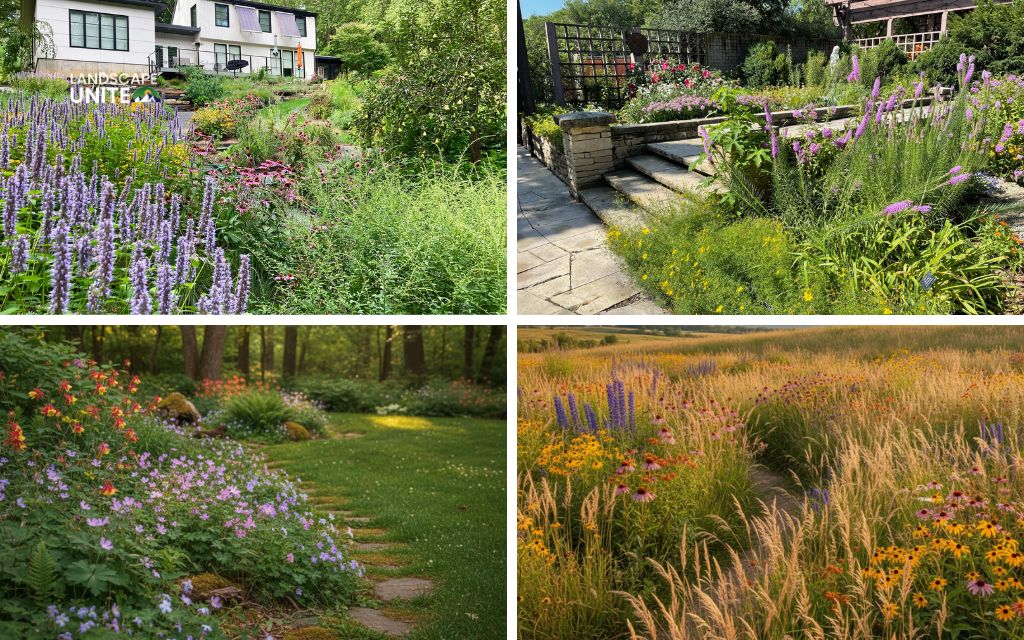
9. Cottage-style wildflower garden
Blend wildflowers with traditional perennials behind picket fences for classic cottage charm. Mix cultivated favorites like roses and delphiniums with native wildflowers to create abundant, romantic color palettes. The slightly untamed aesthetic of wildflowers balances formal perennials perfectly, creating gardens that feel both designed and naturalistic.
10. Modern minimalist wildflower design
Contemporary landscapes benefit from wildflower gardens too. Create structured borders using steel edging or concrete bands, then fill centers with carefully selected wildflowers in a limited color palette. This approach combines the ecological benefits of wildflowers with clean lines that suit modern architecture. The contrast between structured hardscaping and flowing wildflowers creates compelling visual tension.
11. Cutting garden with wildflowers
Grow your own bouquets by dedicating a garden space to wildflowers perfect for cutting. Zinnias, Cosmos, Rudbeckia, and Coreopsis provide armloads of long-lasting cut flowers throughout summer. Plant in succession every two weeks during spring for continuous blooms. You can harvest regularly without harming your garden’s appearance when you design specifically for cutting.
12. Wildlife habitat garden
Create layered wildflower plantings that support birds, butterflies, and beneficial insects by including host plants where caterpillars can feed and grow. Milkweed hosts Monarch butterflies, while Joe Pye Weed attracts numerous butterfly species. Add a shallow water feature like a birdbath or small pond to provide drinking and bathing opportunities. This comprehensive approach transforms your yard into a true wildlife sanctuary.
33 stunning wildflower garden ideas for functional applications
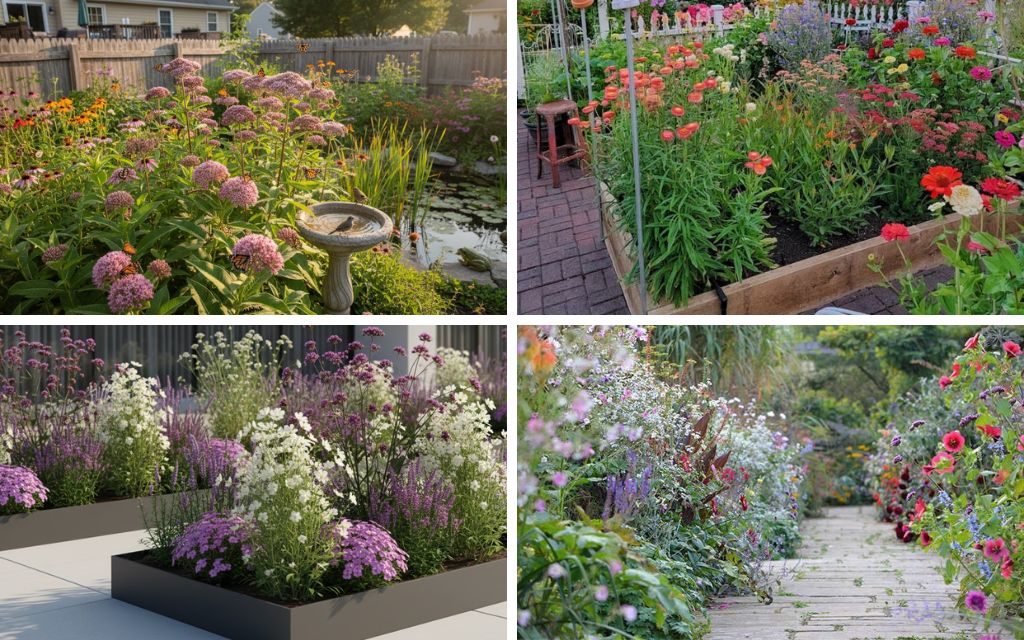
13. Pollinator garden design
Prioritize high-nectar value wildflowers like Bee Balm, Purple Coneflower, and native Asters to support struggling pollinator populations. Plan bloom succession carefully so flowers open continuously from early spring through late fall, providing consistent food sources. Include bare ground areas for ground-nesting bees and leave some stems standing over winter for cavity-nesting species.
14. Rain garden with wildflowers
Turn drainage problems into beautiful solutions with rain gardens featuring moisture-loving native wildflowers. Species like Cardinal Flower, Blue Flag Iris, and Swamp Milkweed thrive in areas that collect water after storms. These bioswale applications filter stormwater runoff while preventing erosion and creating valuable wetland habitat.
15. Butterfly garden focus
Design specifically for butterflies by including both host plants where caterpillars feed and nectar sources for adults. Research which butterfly species live in your region, then choose appropriate host plants. Monarchs need Milkweed, Swallowtails prefer plants in the parsley family, and Painted Ladies love thistles. Create sunny basking spots with flat stones where butterflies can warm themselves on cool mornings.
16. Fire-resistant wildflower zone
In fire-prone regions, create defensible space using low-flammability wildflower species. Avoid plants with high resin or oil content, and keep plantings low and well-watered during fire season. Many native wildflowers like Penstemon and Yarrow naturally contain higher moisture content and burn less readily than ornamental shrubs or dry grasses.
33 stunning wildflower garden ideas for creative concepts
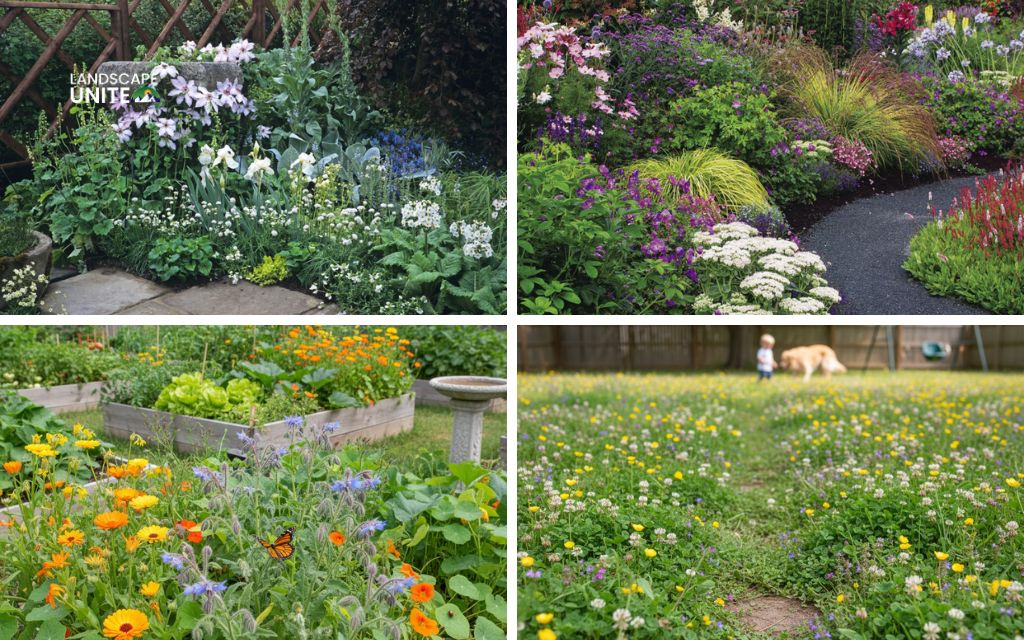
17. Moonlight garden (white wildflowers)
Plant white-flowering wildflowers like White Coneflower, Evening Primrose, and white Cosmos for a garden that glows in moonlight. These magical spaces offer enchanting evening experiences and attract night-pollinating moths. The luminous quality of white blooms creates dramatic impact in shaded areas where colored flowers might fade into darkness.
18. Four-season interest wildflower garden
Select wildflowers that provide visual interest beyond their bloom period. Many Echinacea varieties have prominent seed heads that attract winter birds. Ornamental grasses add movement and structure during cold months. Plan carefully to ensure your garden offers beauty in every season, not just summer’s peak bloom.
19. Wildflower and vegetable garden integration
Interplant wildflowers throughout your vegetable garden to attract pollinators for better fruit set and predatory insects that control pests. Calendula, Borage, and Nasturtiums serve dual purposes as both edible flowers and pollinator attractants. This companion planting approach improves vegetable yields while reducing pest problems naturally.
20. Wildflower lawn alternative (clover + wildflowers)
For families who need some lawn functionality for play or pets, create a mixed planting of low-growing clover with tough wildflowers that tolerate light foot traffic. This approach reduces mowing needs while providing more environmental benefits than pure turf grass. The clover fixes nitrogen, reducing fertilizer needs for remaining lawn areas.
21. Heritage/heirloom wildflower garden
Grow native wildflowers that indigenous peoples used for food, medicine, or materials. Varieties like Purple Coneflower, Bee Balm, and native Sunflowers connect you to horticultural history while supporting modern wildlife. Research the cultural significance of regional native plants to deepen your connection to place.
22. Xeriscaping with wildflowers
In arid regions, native wildflowers form the backbone of water-wise xeriscaping. Desert Marigold, Penstemon, and California Poppy create vibrant displays with minimal irrigation once established. These drought-adapted species often require zero supplemental watering after their first growing season.
23. Children’s exploration wildflower garden
Create magical spaces where children can explore nature safely. Plant large-scale wildflowers like Sunflowers that tower overhead and fast-growing varieties like Zinnias that provide quick gratification. Include species that attract visible wildlife like butterflies and bees, turning your garden into an outdoor classroom about ecology and pollination.
24. Color-themed gardens
Design monochromatic or limited palette gardens using wildflowers in specific color families. A blue and purple garden featuring Bachelor’s Buttons, Asters, and Bee Balm creates calming, cohesive visual impact. Yellow-themed gardens with Rudbeckia, Coreopsis, and native Sunflowers bring sunny cheerfulness. These color-themed wildflower garden ideas make design decisions easier while ensuring harmonious results.
25. Fragrant wildflower garden
Select aromatic wildflowers like Sweet Alyssum, Bee Balm, and Yarrow to engage multiple senses. Place fragrant varieties near pathways, seating areas, or windows where you’ll encounter their scents regularly. Evening-blooming fragrant species like Evening Primrose release perfume as temperatures cool, creating memorable twilight garden experiences.
26. Vertical wildflower wall
Use trellises, vertical garden systems, or climbing structures to grow vining wildflowers like Wild Morning Glory or Climbing Aster. This approach maximizes limited space and creates living walls that provide privacy, shade, and pollinator habitat. Vertical wildflower gardens work beautifully on balconies, narrow side yards, or as property line screening.
27. Wildflower green roof
Low-growing, drought-tolerant wildflowers like Sedums and Hens-and-Chicks create living roofs on sheds, garages, or homes. These installations provide insulation, manage stormwater, and create habitat in unexpected places. Green roofs require professional installation for structural considerations, but the ecological benefits make them worthwhile for suitable properties.
28. Parking lot island wildflower conversion
Transform uninspiring commercial or community parking lot islands into pollinator oases. These spaces typically receive minimal care and feature poor soil, making them ideal for low-maintenance wildflower plantings. Coordinate with property managers to demonstrate how wildflowers reduce maintenance costs while improving aesthetic appeal.
29. Church/community space wildflower projects
Organize community wildflower planting projects at schools, churches, or public parks. These collaborative efforts educate participants about native plants while beautifying shared spaces. Community gardens often welcome wildflower additions that support vegetable pollination and create gathering spaces for events.
30. Wildflower succession garden (early/mid/late season)
Design specifically for continuous bloom by combining early spring wildflowers like Columbine, summer bloomers like Coneflowers, and fall favorites like Asters and Goldenrod. This succession planting strategy ensures your garden provides consistent nectar sources for pollinators throughout their active season while offering you uninterrupted color.
31. Wildflower and native grass meadow
The most ecologically authentic wildflower garden ideas integrate native grasses alongside wildflowers at roughly 60% grass to 40% flowers. This ratio mimics natural prairie ecosystems and provides critical habitat for ground-nesting birds and overwintering beneficial insects. The grass structure supports taller wildflowers and creates four-season visual interest.
32. Companion planting with wildflowers
Strategically place wildflowers throughout your landscape to attract beneficial insects that control garden pests. Planting Yarrow and Sweet Alyssum near vegetable beds attracts predatory wasps that feed on aphids and caterpillars. This integrated pest management approach reduces reliance on chemical controls.
33. Geometric pattern wildflower beds
Create formal wildflower gardens using geometric shapes like circles, triangles, or squares defined by hardscaping or low edging. Fill these structured spaces with carefully selected wildflowers for a design that honors both formal garden traditions and naturalistic planting styles. This approach suits historic properties or formal landscapes where completely wild meadows might feel out of place.
FAQs about wildflower garden ideas
Can you just throw wildflower seeds on the ground and they’ll grow?
Simply scattering wildflower seeds on unprepared ground rarely produces good results. Seeds need direct soil contact to germinate successfully. Remove existing vegetation, lightly rake the soil surface, broadcast your wildflower garden seeds, then gently tamp them down or cover with a thin soil layer. However, overseeding an already-established wildflower meadow works when seeds are scattered in late fall and pressed into contact. For best results with new installations, proper site preparation makes all the difference. Need expert help establishing your wildflower garden? Professional guidance ensures successful results from the start.
What are the cons of a wildflower garden?
Wildflower gardens present some challenges including first-year weed pressure while plants establish, potentially patchy appearance without proper planning, possible neighbor concerns about “messy” aesthetics, risk of introducing invasive species if non-native varieties are chosen incorrectly, and limited recreational functionality compared to lawns for active play or sports. Most disadvantages prove manageable through proper species selection and strategic placement. Consider starting with smaller borders before converting entire properties. For personalized advice balancing wildflower benefits with your specific needs, connect with landscape professionals who understand both aesthetics and ecology.
What is the best time to plant wildflowers?
Fall planting from September through November provides optimal results in most regions. Seeds undergo natural cold stratification over winter, breaking dormancy and triggering vigorous spring germination. Early spring planting works well too when soil temperatures reach 55-70°F and frost danger passes. In southern zones 8-10, fall planting aligns with rainy seasons. Northern zones 4-6 benefit from late fall or early spring seeding. Fall-planted wildflower garden seeds consistently outperform spring-planted ones due to natural winter conditioning. Timing varies by species, so research specific plants you’re growing. Professional landscapers can provide region-specific timing guidance.
How long does it take for a wildflower garden to look established?
Expect mixed timelines depending on plant types. Annual wildflowers bloom their first season, providing color within 10-14 weeks after planting. Perennial wildflowers follow the “sleep, creep, leap” principle: the first year focuses on root establishment with minimal visible growth, the second year shows moderate development and some flowering, and the third year brings full maturity with robust blooms. Well-planned gardens combining both annuals and perennials provide first-year beauty while perennials develop into self-sustaining ecosystems. Patience during establishment pays dividends with decades of low-maintenance beauty. For help designing gardens that provide interest during the establishment phase, explore professional design services.
Do wildflower gardens attract unwanted pests?
Wildflower gardens attract far more beneficial insects than pests. Pollinators like bees, butterflies, and hummingbirds provide beauty and ecological services. Predatory insects including ladybugs and beneficial wasps naturally control pest populations. While wildflowers may draw rabbits, deer, or groundhogs, these typically prove manageable with fencing or selecting less palatable species. The increased biodiversity actually helps control true pest problems naturally rather than creating them. The wildlife attracted to your wildflower garden is overwhelmingly beneficial and beautiful, creating a healthy, balanced ecosystem that supports life throughout your entire property.
Conclusion
Creating wildflower garden ideas transforms your landscape while supporting critical pollinator populations and dramatically reducing maintenance demands. Whether you’ve been inspired by cottage-style borders, dramatic meadows, or functional pollinator pathways, the wildflower garden ideas explored here offer possibilities for every property size and style preference.
Take action now: start small with a border or parking strip, select native species suited to your region, and prepare your site this season. Your future self will thank you when you’re enjoying waves of color with minimal effort.
Landscape Unite serves as your trusted resource for gardening and landscape inspiration that balances beauty with sustainability. Ready to discover more ways to transform your outdoor spaces? Contact Landscape Unite for expert tips, detailed guides, and fresh inspiration. Explore our blog for your next garden adventure and join a community of gardeners creating landscapes that work with nature instead of against it!
